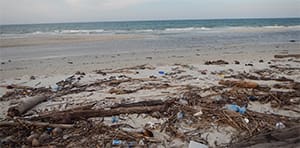To the editor: Cruisers often look for ways to help people in the villages they visit. Some teach, while others bring supplies or provide medical services. Here’s an idea for the engineers among us: Help islands set up sustainable plastic recycling.
Small islands are closed systems. Anything that enters has to either become part of the ecosystem (be used) or be taken off the island. Yet once a week, or maybe once a month depending on the shipping schedule, supplies are brought onto islands in non-degradable plastic containers. Unless someone organizes a way to collect the plastic refuse and ship it off, it simply accumulates in dumps and backyards. A good percentage ends up in the sea.
This can happen deliberately — I recall a very tidy island in Panama that was neat because the residents swept refuse off the ends of their streets and into the sea. It also happens by carelessness or accident; in Ambon, Indonesia, people piled garbage into canals that ran between their houses and the lifting tide pulled layers off into the harbor. Then there’s the plastic that washes in from other places, especially on Pacific beaches where easterly tradewinds blow trash from ships and the American mainland. Both sources, local and distant, spring from the same conundrum: the persistence of plastic and its usefulness.
When we cruised on our Peterson 44, Oddly Enough, we pitched aluminum cans into deep ocean on the theory that metal would dissolve quickly in saltwater. Plastic, at least in the resins it’s made from today, doesn’t degrade but instead just breaks into smaller pieces. Burning plastic refuse indoors is dangerous without an incinerator. Among lightly populated Central Pacific atolls, we took trash ashore and burned it on open pit fires, reducing it to ash and I’m sure spreading toxic gas even though the amount we burned was tiny. Not all plastic is equally toxic to burn, but water bottles — clear containers made of polyethylene terephthalate (PET) with recycling symbol No. 1 — are a problem. This is a pity since water bottles are ubiquitous the world over.
There is a much better solution for any island on a shipping route. PET is highly recyclable. One plastic water bottle can essentially be made into another. Used PET bottles are broken down into small pieces called flake and then fed into machines that heat them into resin to pour into molds in a bottle manufacturing plant. After a certain amount of attrition (bottle plastic can’t be endlessly recycled) and accounting for all the people who don’t recycle, about 30 percent of clear plastic PET in the U.S. is made into new bottles. The success rate depends on the care consumers take to get used bottles into the recycling stream.
Used PET bottles have economic value as scrap, a commodity that is bought and sold on an exchange. This means an incentive system could work. Islands with small populations and resources could set up a system to collect and sort plastic after it’s discarded, using drop-in collection centers or even collecting from homes and businesses with collectors getting paid out of the money made when the plastic is sold to manufacturers.
 |
|
Clear water bottles made of polyethylene terephthalate (PET), like these found on the beach in Indonesia, are highly recyclable. |
|
Ann Hoffner |
Most of the islands we visited had a barter economy — islanders trade items they make, grow or previously traded for stuff they like or need, including cash they can use for school fees, rice, noodles, salt, Johnny Walker, canned corned beef, etc. Plastic containers they’ve already paid for with valuable cash represent net waste if they are simply discarded.
Compacting masses of used bottles into handleable shapes makes it possible to sell them to manufacturers overseas, but this process requires a machine. The most sustainable solution would be for the islanders to make a baler from technology already on the island using parts readily available.
The agricultural extension service of North Carolina has downloadable plans for a hand-operated plastic bottle baler modified from a Kentucky tobacco leaf baler. It requires plywood, two-by-four lumber, fasteners and an automobile jack to act as a press. The plywood would have to be salvaged; packing crates often contain both plywood and lumber. The jack can be salvaged as well. This baler would also have the potential to compact aluminum cans.
Supply ships are equipped to handle heavy and bulky items. A baler on the wharf could compact plastic and take advantage of the ship’s equipment to avoid extra transportation. You’d need a way to account for money, but any island that receives shipments has one already — usually a store or a government office.
International recyclers are paying, on average, $0.20 per pound for clear PET bottles. It takes 18 500-milliliter water bottles to make a pound, according to NAPCOR, the U.S. trade group for such plastics. That boils down to roughly $.011 per collected bottle; this may not seem like much, but it certainly amounts to something in an island economy, especially where residents produce or catch most of their own daily needs.
Even in countries with a cash economy instead of barter, a plastics baler and collection system would be a way of reducing non-degradable refuse that would make a little money to be used for amenities the island otherwise couldn’t afford.
—Ann Hoffner voyaged for years with her husband aboard their Peterson 44 Oddly Enough.

